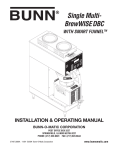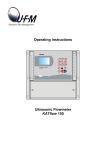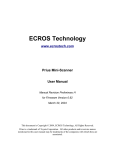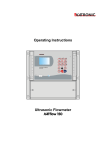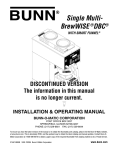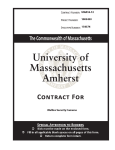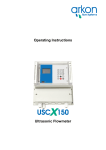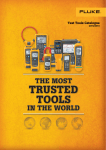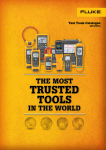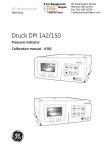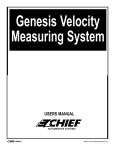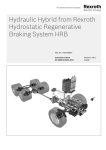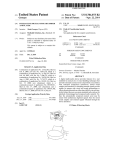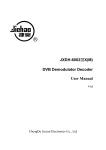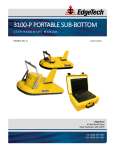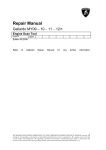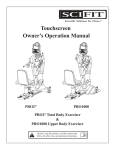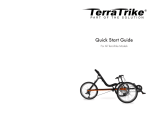Download GE Sensing - Masterflex
Transcript
GE Sensing Houston Center User’s Manual Printing & Assembly Instructions PRINTING: 1. FRONT & BACK COVER PAGES: Front and Back cover pages (first and last pages) will be printed in color, single-sided on 8-1/2” x 11”, 65 lbs white paper. 2. INTRODUCTION PAGES: Introduction section pages (up to Section 1.0) will be printed in color, single-sided on 81/2” x 11”, 24 lbs white paper. 3. SECTION & APPENDIX PAGES: All Sections and Appendix pages will be printed in color, double-sided on 8-1/2” x 11”, 24 lbs white paper. ASSEMBLY: User’s Manual will be assembled with front and back 8-3/4” x 11-1/4” Clear View Plastic Covers, bound with black spines of appropriate size. PACKAGING: The assembled User’s Manual will be packed in a clear plastic bag, or Saran-wrapped. The package is labeled with bar-coded part number as per purchase order. (This page not to be printed.) 1 GE Sensing Models covered: Pressurements Oil Operated Instruments: P3111; P3112; P3113; P3114; P3115; P3116 P3123; P3124; P3125 Distilled Water Operated Instruments: P3211; P3213; P3214; P3223; P3224 Hydraulic Deadweight Tester User’s Manual imagination at work HYDRAULIC DEADWEIGHT TESTER PRESSUREMENTS MODELS: P3100 & P3200 SERIES USER’S MANUAL GE SENSING 10311 WESTPARK DRIVE HOUSTON, TEXAS 77042 (713) 975 0547 FAX: (713) 975 6338 Release: 3100P-1D01 Revision: B Date: 09/27/06 WARRANTY GE Sensing warrants its products to conform to or exceed the specifications as set forth in its catalogs in use at the time of sale and reserves the right, at its own discretion, without notice and without making similar changes in articles previously manufactured, to make changes in materials, designs, finish, or specifications. GE Sensing warrants products of its own factory against defects of material or workmanship for a period of one year from date of shipment. Liability of GE Sensing under this warranty shall be limited to replacing, free of charge (FOB Houston, Texas), any such parts proving defective within the period of this warranty, but will not be responsible for transportation charges or consequential damages. The warranty is not made for products manufactured by others which are illustrated and described in GE Sensing catalogs or incorporated in GE Sensing products in essentially the same form as supplied by the original manufacturer. However, GE Sensing agrees to use its best efforts to have original suppliers make good their warranties. COPYRIGHT NOTICE Copyright © 2006 by GE Sensing. All rights reserved. This document may not be reproduced in part or in whole without the express written consent of GE Sensing. DISCLAIMER No representations or warranties are made with respect to the contents of this user’s manual. Further, GE Sensing reserves the right to revise this manual and to make changes from time to time in the content hereof without obligation to notify any person of such revision. TRADEMARK NOTICE is a registered trademark of General Electric Corporation. Trademarks or trade names are subject to state and federal laws concerning their unauthorized use or other infringements. The fact that the product marks or names in this manual do not bear a trademark symbol DOES NOT mean that the product name of mark is not registered as a trademark or trade name. Any queries concerning the ownership or existence of any trademarks or trade names mentioned in this manual should be independently confirmed with the manufacturer or distributor of the product. ii REVISION NOTICE RELEASE NUMBER REV. DATE OF RELEASE 3100P-1D01 A 05/31/06 Original release per DC/RO 25047 3100P-1D01 B 09/27/06 Pump check valve changed. DESCRIPTION iii SAFETY SUMMARY The following are general safety precautions that are not related to any specific procedures and do not appear elsewhere in this publication. These are recommended precautions that personnel must understand and apply during equipment operation and maintenance to ensure safety and health and protection of property. COMPRESSED LIQUID Use of compressed liquids can create an environment of propelled foreign matter. Pressure system safety precautions apply to all ranges of pressure. Care must be taken during testing to ensure that all hydraulic connections are properly and tightly made prior to applying pressure. Personnel must wear eye protection to prevent injury. HEAVY WEIGHTS Lifting and movement of heavy weights can create an environment of strain and impact hazards. Care must be taken during testing to ensure that weight masses are lifted in a manner that avoids over-reaching or twisting, and that the masses are not dropped. Personnel must wear reinforced safety shoes to prevent injury. PERSONAL PROTECTIVE EQUIPMENT Wear eye protection and reinforced safety shoes approved for the materials and tools being used. iv TABLE OF CONTENTS WARRANTY .................................................................................................................................................................... ii COPYRIGHT NOTICE .................................................................................................................................................. ii DISCLAIMER ................................................................................................................................................................... ii TRADEMARK NOTICE ................................................................................................................................................ ii REVISION NOTICE ...................................................................................................................................................... iii SAFETY SUMMARY ..................................................................................................................................................... iv COMPRESSED LIQUID .............................................................................................................................................. iv HEAVY WEIGHTS ........................................................................................................................................................ iv PERSONAL PROTECTIVE EQUIPMENT .............................................................................................................. iv TABLE OF CONTENTS ................................................................................................................................................. v LIST OF FIGURES ........................................................................................................................................................ vii 1.0 GENERAL INFORMATION .................................................................................................................... 1.1 OPERATING PRINCIPLE ........................................................................................................... 1.2 ENVIRONMENTAL CORRECTIONS ....................................................................................... 1.2.1 GRAVITY .......................................................................................................................... 1.2.2 TEMPERATURE ............................................................................................................. 1.2.3 HEAD OF FLUID ........................................................................................................... 1.3 MODEL VARIATIONS ................................................................................................................. 2.0 PREPARATION ........................................................................................................................................... 2-1 2.1 OPERATING FLUID ..................................................................................................................... 2-1 2.2 CONNECTIONS ........................................................................................................................... 2-1 3.0 PRIMING ...................................................................................................................................................... 3-1 4.0 OPERATION ................................................................................................................................................ 4-1 5.0 CALIBRATION IN DIFFERENT PRESSURE UNITS ....................................................................... 5-1 5.1 CONVERSION WEIGHTS .......................................................................................................... 5-1 5.2 SOFTWARE ................................................................................................................................... 5-1 6.0 MAINTENANCE & SERVICING ............................................................................................................ 6-1 6.1 PCU ASSEMBLY (10 mm NOMINAL DIAMETER) ............................................................. 6-1 6.2 PCU ASSEMBLY (2 & 3 mm NOMINAL DIAMETERS) ..................................................... 6-4 6.3 PCU ASSEMBLY (5 mm NOMINAL DIAMETER) ............................................................... 6-7 6.4 TOP PLATE REMOVAL ............................................................................................................. 6-10 6.5 SCREW PUMP ASSEMBLY ..................................................................................................... 6-11 6.6 PRIMING PUMP ASSEMBLY .................................................................................................. 6-13 6.7 CHECK VALVES ......................................................................................................................... 6-15 6.8 RESERVOIR ASSEMBLY .......................................................................................................... 6-17 v 1-1 1-1 1-3 1-3 1-3 1-4 1-4 7.0 FAULT FINDING ........................................................................................................................................ 7.1 POOR PCU SPIN/SENSITIVITY ............................................................................................... 7.2 HIGH PCU FALL RATE ............................................................................................................... 7.3 SYSTEM WILL NOT PRIME ...................................................................................................... 7.4 SYSTEM WILL NOT PRESSURIZE .......................................................................................... 7.5 PRIMING PUMP MALFUNCTION .......................................................................................... 7.6 CANNOT REACH MAXIMUM PRESSURE ........................................................................... 8.0 STORAGE & TRANSPORTATION ....................................................................................................... 8-1 8.1 INSTRUMENT ............................................................................................................................... 8-1 8.2 WEIGHTS ....................................................................................................................................... 8-1 9.0 ANCILLARY EQUIPMENT ...................................................................................................................... 9.1 LIQUID-TO-LIQUID SEPERATOR, Model 5521 ................................................................ 9.2 ANGLE ADAPTER, Model 5543 ............................................................................................. 9.3 POINTER REMOVER/PUNCH, Model 5551 ....................................................................... vi 7-1 7-1 7-2 7-2 7-2 7-3 7-3 9-1 9-1 9-1 9-2 LIST OF FIGURES Figure 1-1 Figure 1-2 Figure 1-3 Figure 1-4 Hydraulic Circuit Schematic................................................................................................... 1-2 Dual PCU Instrument................................................................................................................. 1-4 Single High Pressure PCU Instrument ............................................................................... 1-5 Single Low Pressure PCU Instrument ................................................................................ 1-5 Figure 2-2A Figure 2-2B Figure 2-2C Making pressure Connections .............................................................................................. 2-2 Making Pressure Connections .............................................................................................. 2-3 Test Port Insert............................................................................................................................. 2-4 Figure 4-1 Figure 4-2 Float Height Indicator Post..................................................................................................... 4-1 Weight Rotation .......................................................................................................................... 4-2 Figure 6-1 Figure 6-2 Figure 6-3 Figure 6-5 Figure 6-6 Figure 6-7 Figure 6-8 10mm PCU Assembly................................................................................................................ 6-3 2 & 3 mm PCU Assembly ......................................................................................................... 6-6 5 mm PCU Assembly ................................................................................................................. 6-9 Screw Pump Assembly...........................................................................................................6-12 Priming Pump Assembly........................................................................................................6-14 Check Valve Assemblies ........................................................................................................6-16 Reservoir Assembly..................................................................................................................6-18 vii SECTION 1.0 GENERAL INFORMATION 1.1 OPERATING PRINCIPLE Deadweight Testers are the primary standard for pressure measurement. Utilizing the wellproven Piston-Gauge system, consisting of a vertically mounted, precision lapped Piston and Cylinder assembly, accurately calibrated weight masses (Force) are loaded on the piston (Area), which rises freely within its cylinder. These weights balance the upward force created by the pressure within the system. FORCE PRESSURE = AREA Each weight is marked with the tester serial number, and the pressure measured when placed on a correctly spinning and floating piston. The total pressure measured is the summation of the weights plus the piston weight carrier assembly. The schematic diagram below shows the basic hydraulic circuit for a dual-PCU (Piston Cylinder Unit) instrument. The system is primed with liquid from the Reservoir, and the system pressure is increased by means of the Screw Pump. As liquids are considered incompressible, the displaced liquid causes the pistons to rise within their cylinders to balance the downward force of the weights. Fluids at the same height in a system are at the same pressure, so when the system is in equilibrium (i.e. the piston and weights are floating freely, rotating and falling at it’s natural sink-rate), the pressure generated by the combined mass of the piston and weights equals the pressure within the device under test. The design of a Piston/Cylinder Unit (PCU) fitted to a deadweight tester allows for a very small clearance gap between the piston and cylinder. This is required to allow the working fluid to pass between the components, providing a lubricating film, and preventing metal-tometal contact. Therefore, during the normal operation of a deadweight tester, the working fluid in the system will slowly pass through this clearance gap. This is perfectly normal, and there are Sump Rings around the piston bodies to collect the excess fluid. Although calibration is carried out using one PCU at a time, there is a point during normal operation of a dual-PCU instrument where both PCU’s will rise. This is due to the overlap in pressure range of the two PCU’s. The PCU that is not in use will seal in the fully extended position to avoid additional fluid loss. 1-1 INTRODUCTION HIGH PRESSURE PCU DEVICE UNDER TEST LOW PRESSURE PCU RESERVOIR SCREW PUMP PRIMING PUMP FIGURE 1-1 HYDRAULIC CIRCUIT SCHEMATIC Operating & Storage Specification: Temperature and relative humidity ranges for operation and storage of the deadweight tester. Temperature Relative Humidity (Non-Condensing) Operation 18 to 28 °C 64 to 82 °F Storage 10 to 50 °C 50 to 122 °F 20 to 75 % 0 to 90 % 1-2 INTRODUCTION 1.2 ENVIRONMENTAL CORRECTIONS The deadweight tester has been calibrated to the Gravity, Temperature and Air Density stated on the certificate. Equations and factors are given on the certificate to adjust for any variations in these environmental conditions. 1.2.1 GRAVITY Gravity varies greatly with geographic location, and so will the deadweight tester reading. Due to the significant change in gravity throughout the world (0.5%), ensure that the tester has either been manufactured to your local gravity, or that you have applied the correction from the calibrated gravity. Example: Deadweight Tester calibrated gravity (980.665 cm/s² is the International Standard Gravity) Gravity at site Indicated Pressure TRUE PRESSURE = 980.665 cm/s² 981.235 cm/s² 250 psi 981.235 × 250 980.665 TRUE PRESSURE = 250.1453 psi The ability to determine the local gravity value will depend on the data available in the country that the instrument is to be used in. Some countries have geographic/geological survey/mapping organizations that have the data readily available. If not, the countries’ National Standards Laboratory may be able to recommend a source of suitable information. 1.2.2 TEMPERATURE Temperature and Air Density variations are less significant than gravity. Variations should be corrected for when maximum accuracy is required. Temperature variation example: Deadweight Tester calibrated temperature Operating temperature Percentage change per °C Indicated Pressure TRUE PRESSURE = 250 + (20 − 24 ) × 20°C 24°C 0.002% 250 psi 0.002 × 250 100 TRUE PRESSURE = 249.98 psi 1-3 INTRODUCTION 1.2.3 HEAD OF FLUID The pressure measured is at the top of the test port seal. Vertical height difference between this datum point and the connection to the instrument under test should be corrected for. To correct for vertical heights above and below the datum line, either subtract or add respectively, the amount stated on the certificate. To ensure accuracy is maintained, the piston and weights must be kept clean and undamaged. The tester is accurate when the piston and weights are floating and rotating freely. 1.3 MODEL VARIATIONS This manual covers many pressure ranges and models within the 3100 and 3200 series of instruments. The following illustrations detail the physical appearance of the three basic models: - Models: 3123 3124 3125 3223 3224 FIGURE 1-2 DUAL PCU INSTRUMENT 1-4 INTRODUCTION Models: 3112 3113 3114 3115 3116 3213 3214 FIGURE 1-3 SINGLE HIGH PRESSURE PCU INSTRUMENT Models: 3111 3211 FIGURE 1-4 SINGLE LOW PRESSURE PCU INSTRUMENT 1-5 INTRODUCTION THIS PAGE INTENTIONALLY LEFT BLANK 1-6 INTRODUCTION SECTION 2.0 PREPARATION The deadweight tester must be set up on a level, stable workbench or similar surface. Remove spokes from tool roll and fit to capstan hub. Level the tester using the four adjustable feet to the bubble level attached to the top plate. Rotate reservoir dust cover through ¼ turn and fill reservoir approximately ¾ full with the appropriate fluid. Rotate dust cover back to cover hole. 2.1 OPERATING FLUID 2.1.1 Oil: The instrument is supplied with Shell Spindle Oil 22, our reference 55-655. 2.1.2 Water: Only Distilled or De-ionized Water should be used in the instrument. Great care must be taken when operating any deadweight tester that uses water as it’s operating fluid, as any contamination present within the system will result in degradation of performance, and eventual irreparable damage to the PCU’s. The impurities found in ordinary water supplies are sufficient to affect the spin and sensitivity of the PCU assemblies, and damage the PCU’s. WARNING The system is designed for use with the fluids described above only; use of other fluids can effect the operation and performance of the instrument, and CAN CAUSE PERMENANT DAMAGE. To avoid damage to the instrument, the operator should check the quality of the operating fluid during use. If the fluid becomes discolored, cloudy or particles appear in the reservoir, the system should be drained and flushed with clean fluid. If the device under test (DUT) is from a system operating on different fluid from that of the deadweight tester, the Liquid Separator, Model 5521, can be mounted to the test port of the deadweight tester. This will allow the calibration of the DUT in its normal operating fluid, and prevent cross-contamination of the system, (See Section 9.1). 2-1 PREPARATION 2.2 CONNECTIONS Fit the device under test (DUT) to the test port using the method described below: IMPORTANT Ensure that all devices are internally clean and free from contamination before connecting to the tester. Particle contamination can damage the sensitive piston assemblies, valve seats and screw pump. To avoid cross-contamination from other fluids, and protect the system from particulates, we recommend the use of a Liquid-to-Liquid Separator, (Refer to section 9.0, Ancillary Equipment). WARNING DO NOT use Teflon/PTFE tape on these connections, as this will prevent correct sealing. The Gauge Adapter sealing system is designed for hand-tight sealing up to 20,000 psi / 1,400 bar - wrenches or similar tools are not required – over tightening can cause damage to threads or sealing faces. Before connection, ensure that there is an O-ring fitted to the test port. Check that the sealing face of the device to be fitted is clean and undamaged, as scratches or dents can form leak-paths. 2-2 PREPARATION NOTE: The thread on the test port, and the lower part of the gauge adapters is LEFTHANDED. The following procedure details the correct method for mounting devices using these adapters: - 1. Screw the appropriate gauge adapter fully on to the instrument to be tested. 2. Screw assembly down COUNTER-CLOCKWISE on to test port. Note: Hand-tight is sufficient; ensure that the bottom face contacts the O-ring on the test port. FIGURE 2-2A MAKING PRESSURE CONNECTIONS 2-3 PREPARATION 3. To adjust the position to face forward, hold the gauge adapter and turn the instrument COUNTER-CLOCKWISE, so that it faces forward. 4. Hold the instrument steady, whilst turning the gauge adapter COUNTERCLOCKWISE until it pulls down onto the O-ring. FIGURE 2-2B MAKING PRESSURE CONNECTIONS 2-4 PREPARATION THIS PAGE INTENTIONALLY LEFT BLANK 2-6 PREPARATION SECTION 3.0 PRIMING 3.1 Open reservoir valve one turn counter-clockwise and turn capstan fully in. 3.2 Pump the priming pump two times. 3.3 Close valve* and turn capstan fully out. 3.4 Open valve and turn capstan fully in. Note: During this operation, bubbles may appear in the reservoir, as trapped air is expelled. For large volumes, repeat steps 3.3 & 3.4 until no further bubbles appear. 3.5 With valve open, turn capstan fully out and close valve. The tester is now ready for use. *WARNING Turning the capstan out with the reservoir valve closed will generate approximately 15 inHg / 0.5 bar vacuum. If the DUT is vacuum sensitive, leave valve open during priming operation. 3-1 PRIMING THIS PAGE INTENTIONALLY LEFT BLANK 3-2 PRIMING SECTION 4.0 OPERATION 4.1 Select the required weights and stack them on the appropriate piston assembly. The pressure measured is the sum of the weights plus the piston/weight carrier. Dual PCU models: The PCU’s are matched in a ratio of effective areas, 20:1 or 10:1 - depending upon model, and the weights will be marked accordingly with both high and low pressure values. Note: The priming pump is intended for system priming only, and cannot be used to generate high pressures. Turn the capstan in (clockwise) to generate pressure. When the piston rises, ensure that the bottom face of the lowest weight is level with the groove, midway in the recessed area on the indicator post. Low Pressure Float Range Weight (Low Pressure) } 4.2 Weight (High Pressure) } High Pressure Float Range FIGURE 4-1 FLOAT-HEIGHT INDICATOR POST Note: This is the PCU mid-float position, which is the point at which all internal corrections have been made with reference to the pressure datum (at the top of the test port). The recessed area is simply a guide for the operator to indicate the PCU travel limits. 4.3 Gently rotate the weight stack clockwise, such that it is turning between approximately 10 and 60 rpm. Avoid side-loads when turning the weights by placing the palms of the hands on either side and “rolling” the stack by pulling in opposite directions, see Figure 4-2. DO NOT rotate weights when the piston is against the top or bottom limits of travel. 4-1 OPERATION IMPORTANT NOTES FOR CORRECT OPERATION OF WATER-OPERATED INSTRUMENTS. (3200 Series) To avoid damage to the sensitive PCU’s, it is vital to ensure that there is a continuous film of water between piston and cylinder. Due to the very close fit of these components, the water film can break down very quickly after use, due to evaporation, surface tension and capillary action effects. Before using the instrument after a period of inactivity: Low Pressure: Hold the weight carrier table, and gently lift the piston assembly vertically, slowly turning to check for freedom of movement. High Pressure: Lift off the weight carrier tube assembly. Hold the piston cap, and gently lift the piston assembly vertically, slowly turning to check for freedom of movement. Under no circumstances should excessive force be used on the piston assembly, as this may lead to permanent damage. It should never be forced, or pulled, in such a way that a bending movement is applied to it. To aid in piston lubrication and movement, it is sometimes helpful to gently pressurize the system to a maximum of 15 psi/1 bar. If any resistance or “grittiness” is felt, the PCU has either dried out too much to use in its current condition, or the system has been contaminated. In either case, the PCU must be removed and dismantled for cleaning, see Section 6. If, after cleaning, the PCU’s performance deteriorates quickly, it confirms that the system is contaminated. If this is the case, the instrument must be completely dismantled and cleaned before further operation of the PCU assembly. 4-3 OPERATION THIS PAGE INTENTIONALLY LEFT BLANK 4-4 OPERATION SECTION 5.0 CALIBRATION IN DIFFERENT PRESSURE UNITS The deadweight tester can be used to calibrate in different pressure units in either of two methods: 5.1 CONVERSION WEIGHTS A set of Conversion Weights can be supplied, marked in the required pressure unit, and adjusted to the correct mass for use with the existing piston(s). The set includes (where applicable) a replacement low-pressure weight carrier table, and a replacement high-pressure weight carrier ring. These items are simply exchanged for the original items when using the conversion weights. Calibration is carried out as described above, with logical pressure increments throughout the operating range, avoiding the need to perform pressure unit conversion calculations. 5.2 SOFTWARE PressCal software is available for use with deadweight testers, and will allow users to apply all necessary corrections (e.g. local gravity, temperature, pressure head, etc.) to enhance the pressure measurement accuracy of the instrument. It will allow calibration in any of 12 different pressure units, using the existing weight set. 5-1 CALIBRATION IN DIFFERENT PRESSURE UNITS THIS PAGE INTENTIONALLY LEFT BLANK 5-2 CALIBRATION IN DIFFERENT PRESSURE UNITS SECTION 6.0 MAINTENANCE & SERVICING IMPORTANT The piston / cylinder assembly is the most critical and sensitive part of the deadweight tester. To maintain accuracy, the piston must always slide freely in the cylinder, and the hydraulic fluid must remain clean. The Figures on the following pages detail the components of each assembly, together with the relevant part numbers. Where “SPEC” appears as a part number, this indicates that this particular component varies with the specification of the deadweight tester, and is usually associated with other components in an assembly for replacement purposes. 6.1 PCU ASSEMBLY (10 mm NOMINAL DIAMETER) Piston Disassembly: 6.1.1 Hold the weight carrier (1), and lift the piston to its full extent. Tap the carrier sharply down onto the cylinder (2) to release the tapered fit between the piston and carrier. Remove the weight carrier. 6.1.2 Unscrew the PCU assembly from the instrument; use the dowel hole if the cylinder is tight. 6.1.3 Carefully withdraw the piston from the cylinder. 6.1.4 If required, lift support ring (4) from around o-ring (3), the o-ring can now be withdrawn from the piston. Piston Cleaning: 6.1.5 Use “non-fluffing”, non-abrasive, lint-free tissue or absorbent cloth. Hold the piston by the larger “head” end, and rub the tissue back and forth along its length. 6.1.6 To remove all traces of contamination (especially important with Water Operated Testers), the piston can be cleaned in a suitable solvent. Note: O-ring seals (where fitted) are Nitrile rubber, and should not be immersed in solvents, as they will become damaged. They should be wiped carefully with a new tissue 6.1.7 After removal from the solvent, using a NEW tissue, repeat the cleaning procedure in 6.1.5. 6.1.8 Place piston carefully on a NEW tissue where it will not be damaged while the cylinder is cleaned. IMPORTANT NEVER TOUCH THE WORKING SURFACE OF A CLEAN PISTON WITH BARE FINGERS – THE NATURAL OIL IN YOUR SKIN CAN CAUSE THE PISTON AND CYLINDER TO STICK. 6.1.9 Wipe excess fluid from the outside surfaces of the cylinder (2). 6-1 MAINTENANCE & SERVICING 6.1.10 Roll a NEW tissue into a tapered rod of appropriate size. Force the tissue through the cylinder bore whilst rotating. Ensure that the tissue is a tight fit inside the bore so that dirt and contamination is removed. 6.1.11 Repeat 6.1.10, using a NEW tissue, but from the opposite end of the cylinder. 6.1.12 Immerse the cylinder in a suitable, clean solvent, see note in 6.1.6 above. 6.1.13 After removal from the solvent, using a NEW tissue, repeat the cleaning procedure in 6.1.10 & 11. Piston Re-assembly: 6.1.14 Replace the clean support ring (4) over the tapered end of the piston, followed by the o-ring (3). Slide the o-ring to the bottom of the piston so that it holds the support ring in place. 6.1.15 Holding the piston by the larger “head” end, dip the other end into a container of clean operating fluid, and transfer to the bore in the underside (threaded end) of the cylinder. Allow the fluid to run through the bore. Repeat this 2 or 3 times to ensure a good film of clean operating fluid exists in the cylinder bore. 6.1.16 Carefully introduce the piston into the underside of the cylinder, and push gently through (the piston will normally slide freely through due to its own weight). NEVER FORCE THE PISTON INTO ITS CYLINDER OR DAMAGE WILL RESULT. If resistance is felt, introduce more fluid. If resistance continues, re-clean piston, cylinder or both. If, after repeated cleaning, the piston still will not slide freely within the cylinder, then permanent damage may have occurred. In which case, the parts should be returned to the factory for evaluation or replacement. 6.1.17 Stand assembly upright on a clean, hard, stable surface. Ensure that the oring (3) and support ring (4) are both located centrally around the piston. Push the cylinder down so that the o-ring is forced evenly inside the support ring. 6.1.18 Ensure that the weight carrier (1) is clean (especially the central mounting hole), and place on the tapered end of the piston. Tap lightly using the palm of the hand to locate on the taper. 6.1.19 Carefully screw the assembly into the instrument, ensuring that the seal (6) is clean and undamaged, and correctly re-fitted. Replacement PCU Assembly Note: The piston and cylinder assembly is a matched pair, which is calibrated and adjusted to a calculated mass figure. If, for any reason, the piston or cylinder becomes damaged, then the entire assembly must be replaced. The replacement assembly consists of the following components: Item numbers 1 through 5. 6-2 MAINTENANCE & SERVICING 6.2 PCU ASSEMBLY (2 & 3 mm NOMINAL DIAMETERS) Piston Disassembly: 6.2.1 Lift off the weight carrier assembly (1 & 2), and unscrew the piston nut (5). Use the dowel hole if the nut is tight. Remove the piston/cylinder assembly. 6.2.2 Loosen set screw (3) in piston cap (4), and gently pull the piston cap from the piston. DO NOT PULL IN SUCH A WAY THAT THE PISTON CAN BEND. The piston and cylinder assembly (6,7 & 8) can now be removed from the piston nut. 6.2.3 Gently withdraw the piston (8) from the cylinder (6). Piston Cleaning: 6.2.4 Use “non-fluffing”, non-abrasive, lint-free tissue or absorbent cloth. Hold the piston by the larger “head” end, and rub the tissue back and forth along its length. 6.2.5 To remove all traces of contamination (especially important with Water Operated Testers), the piston can be cleaned in a suitable solvent. Note: O-ring seals (where fitted) are Nitrile rubber, and should not be immersed in solvents, as they will become damaged. They should be wiped carefully with a new tissue. 6.2.6 After removal from the solvent, using a NEW tissue, repeat the cleaning procedure in 6.2.5. 6.2.7 Place piston carefully on a NEW tissue where it will not be damaged while the cylinder is cleaned. IMPORTANT NEVER TOUCH THE WORKING SURFACE OF A CLEAN PISTON WITH BARE FINGERS – THE NATURAL OIL IN YOUR SKIN CAN CAUSE THE PISTON AND CYLINDER TO STICK. 6.2.8 Wipe excess fluid from the outside surfaces of the cylinder (6). 6.2.9 Roll a NEW tissue into a tapered rod of appropriate size. Force the tissue through the cylinder bore whilst rotating. Ensure that the tissue is a tight fit inside the bore so that dirt and contamination is removed. 6.2.10 Repeat 6.2.9, using a NEW tissue, but from the opposite end of the cylinder. 6.2.11 Immerse the cylinder in a suitable, clean solvent, see note in 6.2.5 above. 6.2.12 After removal from the solvent, using a NEW tissue, repeat the cleaning procedure in 6.2.9 & 10. Piston Re-assembly: 6.2.13 Replace o-ring (7) in the counter-bore in the underside of the cylinder (F), ensuring that it is located correctly and evenly. 6-4 MAINTENANCE & SERVICING 6.2.14 Holding the piston by the larger “head” end, dip the other end into a container of clean operating fluid, and transfer to the bore in the underside of the cylinder. Allow the fluid to run through the bore. Repeat this 2 or 3 times to ensure a good film of clean operating fluid exists in the cylinder bore. 6.2.15 Carefully introduce the piston into the underside of the cylinder, and push gently through. 6.2.16 NEVER FORCE THE PISTON INTO ITS CYLINDER OR DAMAGE WILL RESULT. If resistance is felt, introduce more fluid. If resistance continues, re-clean piston, cylinder or both. If, after repeated cleaning, the piston still will not slide freely within the cylinder, then permanent damage may have occurred. In which case, the parts should be returned to the factory for evaluation or replacement. 6.2.17 Insert piston/cylinder assembly into piston nut (5) through the threaded end, such that the shoulder on the cylinder is located within the central bore of the nut. 6.2.18 Replace piston cap (4), and secure with set screw (3), DO NOT OVERTIGHTEN. 6.2.19 Carefully screw the assembly into the instrument, ensuring that the o-ring (10) is clean and undamaged, and correctly fitted to the piston post (11). 6.2.20 Replace weight carrier assembly (1 & 2), ensuring that it locates correctly on the piston cap. Replacement PCU Assembly Note: The piston and cylinder are a matched pair, which is calibrated and adjusted to a calculated mass figure. If, for any reason, the piston or cylinder becomes damaged, then the entire assembly must be replaced. The replacement assembly consists of the following components: Item numbers 1 through 8. 6-5 MAINTENANCE & SERVICING 6.3 PCU ASSEMBLY (5 mm NOMINAL DIAMETER) Piston Disassembly: 6.3.1 Lift off the weight carrier assembly (1 & 2), and unscrew the piston nut (5). Use the dowel hole if the nut is tight. Remove the piston/cylinder assembly. 6.3.2 Loosen set screw (3) in piston cap (4), and gently pull the piston cap from the piston. DO NOT PULL IN SUCH A WAY THAT THE PISTON CAN BEND. The piston and cylinder assembly (6 & 7) can now be removed from the piston nut. 6.3.3 Gently withdraw the piston (6) from the cylinder (7). Piston Cleaning: 6.3.4 Use “non-fluffing”, non-abrasive, lint-free tissue or absorbent cloth. Hold the piston by the larger “head” end, and rub the tissue back and forth along its length. 6.3.5 To remove all traces of contamination (especially important with Water Operated Testers), the piston can be cleaned in a suitable solvent. Note: O-ring seals (where fitted) are Nitrile rubber, and should not be immersed in solvents, as they will become damaged. They should be wiped carefully with a new tissue. 6.3.6 After removal from the solvent, using a NEW tissue, repeat the cleaning procedure in 6.3.5. 6.3.7 Place piston carefully on a NEW tissue where it will not be damaged while the cylinder is cleaned. IMPORTANT NEVER TOUCH THE WORKING SURFACE OF A CLEAN PISTON WITH BARE FINGERS – THE NATURAL OIL IN YOUR SKIN CAN CAUSE THE PISTON AND CYLINDER TO STICK. 6.3.8 Wipe excess fluid from the outside surfaces of the cylinder (6). 6.3.9 Roll a NEW tissue into a tapered rod of appropriate size. Force the tissue through the cylinder bore whilst rotating. Ensure that the tissue is a tight fit inside the bore so that dirt and contamination is removed. 6.3.10 Repeat 6.3.9, using a NEW tissue, but from the opposite end of the cylinder. 6.3.11 Immerse the cylinder in a suitable, clean solvent, see note in 6.3.5 above. 6.3.12 After removal from the solvent, using a NEW tissue, repeat the cleaning procedure in 6.3.9 & 10. Piston Re-assembly: 6.3.13 Holding the piston by the larger “head” end, dip the other end into a container of clean operating fluid, and transfer to the bore in the underside of the cylinder. Allow the fluid to run through the bore. Repeat this 2 or 3 times to ensure a good film of clean operating fluid exists in the cylinder bore. 6-7 MAINTENANCE & SERVICING 6.3.14 Carefully introduce the piston into the underside of the cylinder, and push gently through. 6.3.15 NEVER FORCE THE PISTON INTO ITS CYLINDER OR DAMAGE WILL RESULT. If resistance is felt, introduce more fluid. If resistance continues, re-clean piston, cylinder or both. If, after repeated cleaning, the piston still will not slide freely within the cylinder, then permanent damage may have occurred. In which case, the parts should be returned to the factory for evaluation or replacement. 6.3.16 Insert piston/cylinder assembly into piston nut (5) through the threaded end, such that the shoulder on the cylinder is located within the central bore of the nut. 6.3.17 Replace piston cap (4), and secure with set screw (3), DO NOT OVERTIGHTEN. 6.3.18 Carefully screw the assembly into the instrument, ensuring that the o-ring (9) is clean and undamaged, and correctly fitted to the piston post (10). 6.3.19 Replace weight carrier assembly (1 & 2), ensuring that it locates correctly on the piston cap. Replacement PCU Assembly Note: The piston and cylinder assembly is a matched pair, which is calibrated and adjusted to a calculated mass figure. If, for any reason, the piston or cylinder becomes damaged, then the entire assembly must be replaced. The replacement assembly consists of the following components: Item numbers 1 through 7. 6-8 MAINTENANCE & SERVICING 6.4 TOP PLATE REMOVAL Note: In order to perform maintenance procedures on the hydraulic system, the Top Plate Assembly must first be removed from the instrument case. 6.4.1 Depressurize the system, open the reservoir valve, and turn the capstan fully in. 6.4.2 Disconnect any DUT from the test station, and remove the fluid from the reservoir*. 6.4.3 Remove the spokes from the capstan hub of the screw pump. 6.4.4 Remove the 4 screws from the instrument top plate, (1 at the mid-point of each edge). 6.4.5 Hold the top plate assembly by the test station, and tilt the plate so that the rear edge is lifted, but the front edge remains in contact with the instrument case. 6.4.6 Slide the top plate towards the rear until the capstan hub of the screw pump is clear of the front lip of the instrument case. 6.4.7 Lift out the top plate assembly. * The reservoir is fitted with a drain plug, which can be accessed from the underside of the instrument case (Refer to section 6.8). IMPORTANT When handling the top plate assembly, it is good practice to remove the piston assemblies to avoid accidental damage. Note: Replacement is simply the reverse of the above procedure. 6-10 MAINTENANCE & SERVICING 6.5 SCREW PUMP ASSEMBLY 6.5.1 Unscrew the large union nut (just behind the inner hub) of the screw press assembly. 6.5.2 Withdraw the lead screw assembly from the barrel (6), taking care not to drop the rambler assembly (3). 6.5.3 The white, anti-extrusion ring (4) is a PTFE spiral, and can be removed by “unwinding” it from the rambler. 6.5.4 When removing the rambler seal (5), take care not to use any tool that may have a sharp edge that will scratch the surfaces of the rambler, otherwise it may leak when reassembled. 6.5.5 The replacement rambler seal can be eased over the front of the rambler, and into the groove. 6.5.6 Similarly, the new anti-extrusion ring can be “wound” into the groove in the rambler, behind the rambler seal. 6.5.7 If it is necessary to remove the barrel (6), the locknut (7) must be loosened approximately ½ turn. The barrel can then be unscrewed from the test station (9). Note: It is often easier to remove the barrel support bracket (11) to allow greater movement, (remove the 2 screws (12) from the upper side of the top plate). 6.5.8 Before re-fitting the barrel, ensure that the barrel seal (8) is correctly located in the counter-bore in the front of the barrel. Screw the barrel fully in to the test station, and secure with the locknut. 6.5.9 Re-align the barrel support bracket (if removed), and secure through the top plate with the 2 screws (12). 6.5.10 Ensure that the rambler assembly is correctly located on the end of the lead screw assembly. Carefully introduce the rambler into the open end of the barrel; making sure that it does not tilt when entering the barrel. 6.5.11 Push the lead screw assembly fully in to the barrel, ensuring that the key in the nut locates correctly in the slot in the barrel. 6.5.12 Re-tighten the barrel union nut. Note: If the lead screw assembly shows signs of excessive wear, then it is very likely that the associated components have worn also, therefore the screw press assembly is available as a spare part – see diagrams for part numbers. 6-11 MAINTENANCE & SERVICING 6.6 PRIMING PUMP ASSEMBLY Disassembly: 6.6.1 On the underside of the top plate, disconnect the hydraulic tubing from the pump block assembly (1). 6.6.2 On the upper side of the top plate, unscrew locknut (12) ½ turn, and remove clip pin from clevis (13). 6.6.3 The pump arm assembly can be swung out of the way. 6.6.4 Remove locknut (12) and clevis (13). 6.6.5 Unscrew union nut (11), and withdraw pump assembly from below the top plate. 6.6.6 Withdraw pump shaft (9), taking care not to drop shaft bearing (10) or rambler assembly (7). 6.6.7 The white, anti-extrusion ring (6) is a PTFE spiral, and can be removed by “unwinding” it from the rambler. 6.6.8 When removing the rambler seal (5), take care not to use any tool that may have a sharp edge that will scratch the surfaces of the groove in the rambler, otherwise it may leak when reassembled. 6.6.9 The replacement rambler seal can be eased over the front of the rambler, and into the groove. 6.6.10 Similarly, the new anti-extrusion ring can be “wound” into the groove in the rambler, behind the rambler seal. 6.6.11 If it is necessary to remove the barrel (4), the locknut (2) must be loosened approximately ½ turn. The barrel can then be unscrewed from the pump block assembly (1). Reassembly: 6.6.12 Before re-fitting the barrel, ensure that the O-ring (3) is correctly located in the counter-bore in the front of the barrel. Screw the barrel fully in to the test station, and secure with the locknut. 6.6.13 Ensure that the rambler assembly is correctly located on the end of the pump shaft. Carefully introduce the rambler into the open end of the barrel; making sure that it does not tilt when entering the barrel. 6.6.14 Slide the pump bearing (10) over the shaft, and locate it inside the barrel. 6.6.15 Re-introduce the pump assembly from the underside of the top plate, and secure with the union nut (11). 6.6.16 Replace locknut (12) and clevis (13), reconnect pump arm assembly, and secure with pin clip. 6.6.17 Reconnect hydraulic tubing. 6-13 MAINTENANCE & SERVICING 6.7 CHECK VALVES Inlet Check Valve: The inlet check valve is a bought-in item, and is not readily user-serviceable. To remove: 6.7.1 Disconnect nylon tubing from connector (9), by pressing in the collar at the top of the connector, and gently pulling on the tubing. 6.7.2 Unscrew and remove connector. 6.7.3 Remove check valve assembly (8). 6.7.4 When replacing the check valve assembly, take care to remove all traces of PTFE or Teflon sealing tape on the mating threads of elbow (7). New tape (or similar sealing method) must be applied to ensure a pressure-tight joint. 6.7.5 Reassembly is the reverse of removal. Outlet Check Valve: 6.7.6 Remove screws (7) and pump check flange (6), taking care not to drop the check valve bullet (3) and spring (4). 6.7.7 Inspect the parts for cleanliness and damage – particularly the sealing surfaces. 6.7.8 When removing O-rings, take care not to use any tool that may have a sharp edge that will scratch the surfaces of the mating groove, otherwise it may leak when reassembled. 6.7.9 Reassembly is the reverse of removal, but care mast be taken to ensure that the spring and bullet are seated correctly. 6-15 MAINTENANCE & SERVICING 6.8 RESERVOIR ASSEMBLY 6.8.1 To drain the fluid from the reservoir, first remove any weights, and raise the instrument a few inches by placing suitably sized blocks under the feet. 6.8.2 Place a suitable catchment tray or bowl below the reservoir drain (13). 6.8.3 Open the valve by turning valve stem (1) counter-clockwise. 6.8.4 Remove gland nut and plug (13 & 12), and allow the fluid to drop into the catchment tray. To completely disassemble the reservoir, the top plate must be removed from the instrument case (Refer to Section 6.4). 6.8.5 Disconnect the high-pressure tubing by unscrewing the gland nuts fitted to the reservoir body (11). 6.8.6 The low pressure feed to the priming pump is disconnected by pressing down on the black plastic ring at the top of the connector, and gently pulling on the nylon tubing. 6.8.7 Remove valve stem completely by turning counter-clockwise, taking care not to lose the spring (2) and nylon washer (3). 6.8.8 Lift off reservoir cover (4). 6.8.9 Remove three screws from reservoir spacers that hold the assembly to the top plate. The assembly can now be withdrawn from the underside of the top plate. 6.8.10 The reservoir body (11) and reservoir cap (5) are a close fit to the reservoir tube (7), and both rely on the O-ring seal (6) to hold them in place. These parts can be separated by gently pulling them apart. 6.8.11 The valve vent (9) is disassembled from the reservoir body by removing the three screws (8). 6.8.12 Reassembly is the reverse of the above procedure. 6-17 MAINTENANCE & SERVICING SECTION 7.0 FAULT FINDING 7.1 POOR PCU SPIN/SENSITIVITY General: The weights floating on a clean PCU assembly will rotate freely, slowing down gradually to a complete stop. If the rotation stops quickly, then the PCU may be dirty and require cleaning. DO NOT ROTATE THE PISTON IF IT IS DIRTY AS PERMENANT DAMAGE CAN OCCUR. If the spin/sensitivity of a recently cleaned PCU deteriorates quickly, then it is likely that the hydraulic system has become contaminated. During the normal operation of a deadweight tester, the working fluid flows slowly through the tiny gap between the piston and its cylinder. If the hydraulic system has become contaminated, any particles will tend to move towards the PCU(s) and thus affect their performance, and possibly damage them. If this is the case, the system must be completely dismantled, thoroughly cleaned and rebuilt before further calibration is carried out. 7.1.1 10 mm PCU Assembly: Plug the test station to prevent leakage, and open the reservoir valve. Hold the weight carrier (1) and lift gently up and down, the piston should slide freely within its cylinder. If any resistance greater than fluid drag or a “gritty” sensation is detected, then the PCU must be removed and cleaned. (Refer to Section 6.1). 7.1.2 2 & 3 mm PCU Assembly: Pressurize the system with 1 large weight so that the piston is rotating and floating correctly. Gently push down on the rotating weight carrier (2) and release. This should result in a smooth, “bouncing” oscillation. If the piston does not rotate or “bounce” freely, it must be removed and cleaned. (Refer to section 6.2). 7.1.3 5 mm PCU Assembly: Plug the test station to prevent leakage, and open the reservoir valve. Remove the weight carrier assembly (1 & 2). Hold the piston cap (4), and lift gently up and down, the piston should slide freely within its cylinder. If any resistance greater than fluid drag or a “gritty” sensation is detected, then the PCU must be removed and cleaned (see section 6.3). Pressurize the system with 1 large weight so that the piston is rotating and floating correctly. If the piston does not rotate freely, it must be removed and cleaned. (Refer to Section 6.3). 7-1 FAULT FINDING 7.2 HIGH PCU FALL-RATE General: The piston will always fall slowly due to a small leak between the piston and cylinder. fall rate will never be so fast that a stable reading cannot be made. 7.2.1 This If the system has been pressurized quickly, then sufficient time must be allowed for the instrument to thermally stabilize. Continue re-floating the piston until the fall rate stabilizes, this should take no longer than one minute. 7.2.2 If PCU has just been re-fitted after cleaning: Air pockets can be introduced when re-fitting a PCU. This will cause the piston to fall faster while the air bleeds between the piston and cylinder. Continue to re-float the piston until the fall rate slows down. If the piston continues to fall quickly, then check for fluid leakage around the base of the PCU assembly. Check for loose/damaged/dirty seal under the PCU, tighten, clean or replace as necessary (Refer to sections 6.1/6.2/6.3). 7.2.3 Reservoir valve may be leaking. Observe fluid level, it will rise slowly if the valve is leaking. This indicates that the valve seat may be damaged or dirty, or the o-ring below the valve vent may be damaged. It should be disassembled, cleaned and inspected, then retested or replaced as necessary (Refer to section 6.8). 7.2.4 Rambler seal may be leaking. Check lead screw in screw pump for “wetness” when extended, the screw thread should be greased, not running with operating fluid. If lead screw is “wet”, then replace rambler seal and anti-extrusion ring. (Refer to Section 6.5). 7.3 7.4 SYSTEM WILL NOT PRIME 7.3.1 Check reservoir valve is closed. 7.3.2 Check for sufficient fluid in reservoir. 7.3.3 Check for damaged/missing/dirty O-ring on test station. 7.3.4 Check that the face of the DUT is contacting the O-ring, and that the surface is not scored or dented. SYSTEM WILL NOT PRESSURIZE 7.4.1 Ensure correct valve operation during priming process. 7.4.2 Check DUT is not leaking. 7.4.3 Clean system externally, check for fluid leak by continually trying to pressurize. Wherever fluid appears, replace the seal – check sealing faces are clean and undamaged before re-assembly. 7-2 FAULT FINDING 7.5 PRIMING PUMP MALFUNCTION 7.5.1 If pumping does not generate pressure, then the inlet check valve has probably failed, and requires replacement. 7.5.2 If the system pressurizes and depressurizes in conjunction with the downward and upward strokes of the pump, then the outlet check valve has failed completely. This should be disassembled and inspected for dirt or damage to valve seat and seal. After inspection, clean all parts carefully, replace as required, and re-assemble correctly. 7.5.3 If the pump handle rises during normal system pressurization, then the outlet check valve is leaking. Inspect as above. Note: Do not continue to pressurize if pump handle rises, as this can damage the inlet check valve. 7.6 CANNOT REACH MAXIMUM PRESSURE If maximum pressure cannot be reached, even after the screw press has been turned fully in, and the checks above have been made: 7.6.1 Ensure that the screw press is FULLY OUT, and the priming pump is used for initial pressurization. 7.6.2 If the DUT has a large internal volume or there is air in the system, then re-prime (Refer to section 3), increasing the initial pressurization with the priming pump from 100 psi/7 bar to at least 200 psi/14 bar. 7-3 FAULT FINDING THIS PAGE INTENTIONALLY LEFT BLANK 7-4 FAULT FINDING SECTION 8.0 STORAGE & TRANSPORTATION 8.1 8.2 INSTRUMENT 8.1.1 With the test station plugged, open the reservoir valve and turn capstan fully in, close reservoir valve. 8.1.2 Remove spokes from capstan hub, and store in tool-roll. 8.1.3 Remove screw-in handle from pump arm, and store in tool roll. 8.1.4 If fluid is to remain in the reservoir, ensure that the tester is kept level at all times to avoid spills. If not, drain the reservoir as described in Section 6.8. 8.1.5 Refit instrument lid, ensuring that the hinges are correctly engaged, and secure with toggle clips at the sides. WEIGHTS 8.2.1 Starting with the largest increments first, stack all appropriate weights in the wooden weight case. 8.2.2 Pass the threaded rod of the weight clamp assembly down through the center of the weight stack, and locate in the base of the weight box. 8.2.3 Secure the weights by screwing the clamp assembly in clockwise, ensuring that the stepped rim of the clamping disc locates correctly in the center of the weight stack. Close lid and secure with catches at front. 8.2.4 WARNING The weight set is HEAVY (can be up to 80 lbs/36 kg per individual box) so care must be taken when moving it. Both handles must be used when lifting the set for stability, and we recommend that it be carried between two people. 8-1 STORAGE & TRANSPORTATION THIS PAGE INTENTIONALLY LEFT BLANK 8-2 STORAGE & TRANSPORTATION SECTION 9.0 ANCILLARY EQUIPMENT 9.1 LIQUID-TO-LIQUID SEPERATOR, Model 5521 or 5522 If there is any doubt that the instrument to be tested is not internally clean, then the addition of the 5521 Liquid Separator will protect the deadweight tester from contamination and possible damage. The 5521 is also particularly useful in applications where the instruments under test are used on systems that must not be contaminated by the operating fluid from the deadweight tester. The unit contains a flexible diaphragm that separates the two working fluids, preventing transfer either way. Model 5521 has a Viton diaphragm and seals, and a maximum working pressure range of 10,000 psi / 700 bar. Model 5522 has a PTFE diaphragm and EPDM seals, and a maximum working pressure range of 7,000 psi / 500 bar. This unit is specifically designed for use with brake fluids, Skydrol ® and similar liquids. 9-1 ANCILLARY EQUIPMENT 9.2 ANGLE ADAPTER, Model 5543 To calibrate gauges with the pressure connection on the rear (e.g. panel-mount gauges) in their correct position, an angle adapter should be used. The angle adapter fits directly onto the test station, converting it through 90 degrees, allowing the standard adapters to be used. 9.3 POINTER REMOVER/PUNCH, Model 5551 To remove and refit the pointer of a pressure gauge. This tool has a spring-loaded plunger to quickly and consistently refit the pointer. 9-2 ANCILLARY EQUIPMENT U.S.A. 10311 Westpark Drive Houston, TX 77042 T 713 975 0547 F 713 975 6338 imagination at work 3100P-1D01, Revision B September 27, 2006
























































